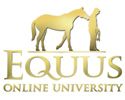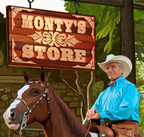I have the opportunity to train a three year old untouched station-bred colt. He has not been handled but has become used to seeing people coming and going past his pasture. I've gotten near him in the pasture when catching another horse, but not touched him.
My first goal is to get a halter on him. My options seem to be either run him into the corral and do join up first then put on the halter, or use a chute (I'm not sure yet if there is a chute available for me).
However, I am surprised at the description in 'Ask Monty' of putting a first halter on using a chute as it sounds very frightening for the horse. I once watched someone do this to a large foal and it managed to flip right over the high rail.
I'm leaning towards the preference of sending my colt into the corral (I have prepared it into an octagonal shape ready for Join-Up), giving him a few minutes to orientate himself, then entering, doing join-up and putting on his first halter, or even just a neck strap.
Once I have completed Join-Up and Follow-Up successfully can I expect the colt to accept wearing a halter? If so, should it be a neck strap of some kind, or a plain halter, or the dually halter so that I can immediately do some teaching to lead with it? I would appreciate advice? Thanks. :)
← back
Horse Behavior and Training
First halter before or after Join-Up?

Rewards
Subscribe to Equus Online University and become a part of Monty's worldwide mission to leave the world a better place for horses and for people too.
Students automatically gain access to special rewards, such as exclusive discounts at the Monty Roberts Online Shop. Visit Monty Roberts Online Shop.



Hi K.D.,
You seem to have thought it all through very well, all your considerations have safety and a positive result in mind. As long as you can invite your colt into the corral without touching him, why not do it? Learning to lead is of course much easier after Join-up. If you put a halter on it should be one with which you could also train him. Remember that you cannot leave the Dually halter on afterwards, so do not turn the colt out with the Dually. This might mean you have to take it off or change halter after your session. Take your time and repeat Join-up the next day or so, to establish what the two of you achieved. Putting on a halter could become part of the routine. You can do some desensitizing with the halter or leadrope.
Miriam
Thank you, Miriam. Very encouraging! I'll let you know how we go. :)
Well Miriam I had an intense, challenging, upsetting and rewarding, learning weekend! I live in New Zealand and am dealing with a lot of horses that have been neglected for a very long time. They live on a large farm station so they've never gone hungry at least, but they're as close to wild (the untouched ones) as I'll probably ever see.
I had three untouched colts to work with. They were so flighty when being moved through cattle yards into the corral that one of them (Reuben), ran blind and face- planted into a wire fence. I was so upset because he had blood on his face where the wire got him. It was my fault for not acting more slowly and I was gutted. I felt a failure. All I could do was hope I'd be able to make it up to him by giving him some love and kindness through join-up and desensitising.
I began with one called Lightning Cloud. He was so sweet and although very unsure, he touched his nose to me and allowed me to begin touching him. It took a very long time of patience but I was able to get a plain halter on him eventually. He did funny things I wasn't prepared for, like he had a roll while I was standing in his personal zone area! And he tried nibbling at the halter and lead and me. The second day he came straight to me at the gate, was singing out to me from the paddock (the other horses glanced at him as if to say 'are you serious?'). When I tried to send him away for join-up he looked so sweet and hurt and really didn't want to run away. He gave me all the gestures really fast and did a stronger join-up and follow-up than the day before. Then I was able to do more stroking and get the dually halter on him. (This is going to be a long message by the way - hope you're not rushing off anywhere - lol). He went stiff and didn't respond at all to any signals from the halter. He pulled back away and the line whizzed through my hand (first and blessedly only injury I received - a webbing burn on the finger) and I had to let him go. But after that we tried again and I found the first response was he'd let his nose be shifted from one side to the other so I rewarded that and eventually I got forward jerky steps. In between though he would try pawing with his front feet so I gave a tug on the dually each time he did that to let him know not to. I hope this was correct? He seemed to be beginning to understand. We did about six steps and I felt to stop and finish on the positive. So generally his progress and sweet nature was a real encouragement to me.
But poor Reuben was traumatised and after two days of trying to get join-up I still wasn't able to touch him. Each day he did get quieter and he took steps towards me but wouldn't come all the way. It was frustrating because I wanted to get some vetadine on the injury but couldn't yet.
The third colt, who was the one in my first message above - his name is Basil - he turned out to be more mature than I'd been informed. I realised he was four - now a stallion - and he behaved the same way as Reuben. He became quieter over the two days and I got within a metre of him, he stepped towards me but didn't come all the way to me.
I will be doing some more work with them this weekend so hope to continue the positive progress.
Before I left I worked some more with a rideable horse and was able to improve his standing still for mounting with the dually - and I rode him in the dually (first time for both of us) and it went really well. One more question while I'm thinking of it - is there a way to say 'see you later' to the horse in Equus? I sometimes feel there's such a strong bond happening and when I leave the horse it feels hard to do for both of us. Looking forward to your response. Thanks heaps for your input on the uni!
Hi T.K.,
What good news, first of all your working with rescuehorses, they deserve it more than any other horse in the world! You seem to be making a good progress, give yourself and above all the horse all the time it needs. Nobody knows how long these horses have lived in the believe that humans are not to be trusted. One step at a time.
Let me try to go through your story:
Lightning Cloud- rewarding what is desirable and making uncomfortable what is undesirable is the road you have taken, I think you're doing a good job. What you describe is "learning", trying a response, finding out what was asked of him. Making the pawing uncomfortable is a good way to address this kind of behavior, sometimes ignoring might be an option, too.As long as you reward the "good" thing. He seems to be doing his utter best for you!
Reuben- To be able to draw him to you, it might be an option to walk away from him instead of standing still, be very passive, like in the Join-up lesson on this Uni " my horse won't come to me", Monty deepens the request by taking a few steps away. No preditor would ever walk away from his prey if at such a close distance. Another option could be mounting the rideable horse and try to approach from the saddle, using the same principles as in Join-up. Like the headshy horse Monty described the other day in the newsletter.
Basil- He seems to have some more confidence, try the "walking-away"-tactic, he will come around, if you're consistent and fair and show him you know his language.
This brings me to your last question, horses live "in the moment", but will remembering good experiences. So if you give the horse a good rub and have some "quality-time" before turning him out after work, he will remember the pleasant feeling you left off with.
Ending every lesson and every session on a positive note contributes a lot to this concept.
Another thing you might want to try is just entering the paddock and be there without an agenda. This is something humans hardly ever do, mostly they enter and take the horse out for work. Become a quiet association to the horse, he'll remember you!
Keep the good work going, thank you for encouraging me on this forum, it's a great tool for learning on all sides of the spectrum.
Miriam